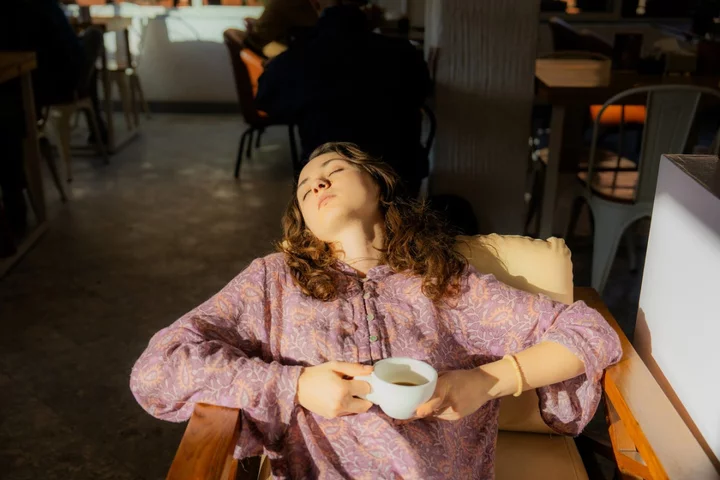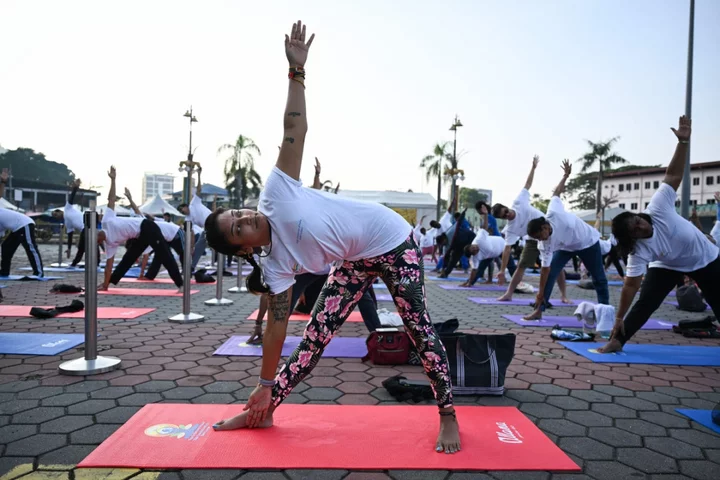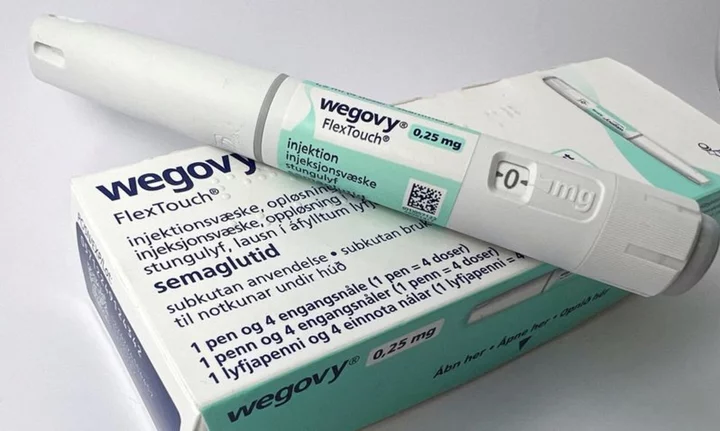
Five Takeaways From a Sweeping Report on Climate Change in the US
A major US government report published today describes how intensifying climate change is disrupting lives and businesses nationwide,
2023-11-14 18:27

Nowhere Is Safe From Worsening Climate Change, New US Report Warns
The floods, heat waves, storms and fires fed by global warming are getting worse across the US and
2023-11-14 18:27

Top 10 hacks to beat the afternoon slump
An expert has revealed how to beat the afternoon slump, including chewing gum, having a ginger shot – and watching cute cat videos. Nutritionist and mental health advocate Rosie Millen, has revealed the top 10 hacks to get yourself out of the energy lull, which also includes grabbing a colouring in book, making a ‘slump’ playlist and spraying your favourite perfume. According to Rosie, watching heart-warming videos of cats can have a huge impact on your mood and energy levels, and also decreases stress. While studies show that simply chewing gum increases blood flow to the brain, which then makes you more alert. And drinking a shot of ginger – which is a natural energy booster – can also help you out of a slump. It comes after a study of 2,000 adults found they suffer an average of three energy slumps a day, with 2.36pm the most common time to hit the wall. But 49 per cent admitted they have no idea how to avoid the energy loss. ‘Lack of sleep was found to be the top cause of an energy slump’ Rosie, who is working with Vitabiotics Feroglobin in a bid to help people cope with the dreaded afternoon slump, said: “We’ve all been there. Some of us more than others. And when it hits, it hits hard. “We all know the obvious solutions on hand – exercise, have a cup coffee or take a nap. “But what are some of the more unconventional hacks at our fingertips that can also help bring you out of your energy lull and allow you to get on with your day.” Following the findings, a quiz has also been created to allow you to test how at risk of a slump you are, and whether you need to work to boost your energy levels. A lack of sleep was found to be the top cause of an energy slump for 45 per cent, followed by not drinking enough water (25 per cent), not exercising (22 per cent) and not having the right foods (21 per cent). But 19 per cent blamed it on having to complete a boring activity while 12 per cent suffer a slump when they are in a meeting that goes on for too long. Worryingly, 34 per cent have even had an energy slump while driving. As the result of the lull in their energy levels, 21 per cent have cried and 19 per cent have argued with their partner. Others admitted to cancelling a social engagement (19 per cent), forgetting they were meant to be somewhere (16 per cent) or shouting at their children (15 per cent). While 12 per cent have even fallen asleep in a meeting and 10 per cent have made a mistake at work. But in a bid to beat the slump, 37 per cent have turned to coffee while the same percentage has tried going for a walk outside. Three in 10 consume sugary snacks, 26 per cent splash their face with water and 12 per cent put some loud music on. It also emerged the average adult complains of feeling tired three times a day, with 39 per cent admitting their lack of energy is often a topic of conversation with friends. However, a quarter of those who suffer with energy slumps, polled via OnePoll, have been so concerned, they have visited a doctor or medical professional. To try and boost their energy levels and avoid a slump, 38 per cent have attempted to improve their sleeping pattern while 36 per cent have done more exercise. Others have changed their diet (30 per cent), taken supplements (30 per cent) or taken more breaks throughout the day (26 per cent). A spokesperson for Vitabiotics Feroglobin said: “We’ve all experienced an energy slump – and when it hits, it can be really hard to get out of it. “But as well as learning how to beat it, it’s important to learn how to avoid the slump in the first place. “Your diet and nutrition can have a huge impact on your energy levels, so making sure you are eating the right foods and getting the vitamins and minerals you need can go a long way to beating the slump.” Here are some top tips to beat the slump: 1) Watch cute cat videos Believe it or not, watching cat videos can have a profound effect on your mood and energy levels. A study from the Indiana University Media School of 7,000 people found that watching cat videos not only improves your mood but also decreases stress and re-energises you for when you return to your work. 2) Eat an iron rich snack You need iron to carry oxygen to the muscles and organs in the body. When iron levels are low, this can contribute to fatigue. So make sure you get some iron rich snacks every day to keep your levels up. Good recommendations include dried fruit and pumpkin seeds, dark chocolate and houmous with chopped veg. 3) Chew gum This semi-strange tip actually has science to back it up. A study from the journal of physiology and behaviour found that chewing gum increases blood flow to the brain which in turn improves alertness. 4) Grab a colouring in book Not only does colouring in alleviate stress and reduce anxiety it is like a full brain workout for your neurologic system. While colouring, you use the parts of your brain (the frontal lobe) that enhances focus and concentration. Certain colours, such as yellow and orange, are also thought to increase energy. 5) Jump into an ice bath or have a very cold shower Experts say that cold showers boost the immune system and increase energy levels. Scientists believe it improves circulation and blood flow to and from the muscles. It is also thought to improve your mood. A 2008 study found that the use of cold showers on a daily basis decreases depressive symptoms. 6) Make a playlist Music has an incredible impact on our mood and can absolutely transform your energy levels even in a short space of time. Just popping in your earphones and blasting your favourite song alters brainwaves and improves cognitive performance. New research from the British Academy of Sound Therapy found that after listening to music for just nine minutes, 65 per cent of test subjects reported they were happier and laughed more, 89 per cent had improved energy levels and 82 per cent felt more in control of their lives. So, get a playlist ready before you start to crash. 7) Turn up the lights If you’re feeling slumped turn up the lights in your house. The high colour temperature of bright and cool lights triggers the release of serotonin, which makes us more alert and energetic. Results of a study with 52 test subjects showed that people felt more alert and energized after having been exposed to bright light. Stepping out into the sunshine is also a gamechanger. The effects of vitamin D and energy are well documented. Fatigue is one of the main symptoms of vitamin D deficiency. 8) Spray your favourite perfume A lot of clinical research supports claims that certain essential oils increase energy and relieve fatigue. Peppermint oil, for example, is effective for preventing fatigue and improving exercise performance. And eucalyptus is thought to awaken the mind and increase mental clarity. You can either inhale essential oils directly, spray a perfume with them in, add a few drops to your shampoo or opt for an energising massage (time and finances permitting). 9) Call a friend Unsurprisingly, socialising with friends can be really lifting. Dopamine and oxytocin are released when you socialize which in turn boosts your mood, reduces cortisol levels and lowers stress. In fact, social isolation has more far-reaching negative effects. New research suggests that being alone for too long is comparable to smoking up to 15 cigarettes a day. 10) Have a ginger shot Ginger is a natural energy booster and may be able to give you the kick you are looking for mid-afternoon. Studies suggest it has stimulatory effects. Just make sure you go for as fresh as possible without any added sugar. Read More What are the symptoms of Parkinson's disease and how can it be treated? What is silent reflux? Yoga may reduce seizure frequency in epilepsy patients, scientists say Yoga may reduce seizure frequency in epilepsy patients, scientists say Jonnie Irwin says he ‘never thought’ he’d be alive to see his 50th birthday Billy Connolly shares health update on Parkinson’s disease: ‘Every day gets stranger’
2023-11-14 00:18

Yoga may reduce seizure frequency in epilepsy patients, scientists claim
Doing yoga may help reduce frequency of seizures in people with epilepsy and lower their anxiety, a new study found. The practice may also improve patients’ overall quality of life by reducing the stigma they feel from having the disease, according to the research, published last week in the medical journal Neurology. “People with epilepsy often face stigma that can cause them to feel different than others due to their own health condition and that can have a significant impact on their quality of life,” study author Manjari Tripathi from All India Institute of Medical Sciences (AIIMS) in New Delhi said. “This stigma can affect a person’s life in many ways including treatment, emergency department visits and poor mental health,” Dr Tripathi explained. In the study, researchers assessed people with epilepsy with an average age of 30 in India. They measured stigma among participants based on their answers to questions such as: “Do you feel other people discriminate against you?” “Do you feel you cannot contribute anything in society?” and “Do you feel different from other people?” About 160 people who met the criteria for experiencing stigma were then identified. These patients had an average of one seizure per week and on average took at least two anti-seizure medications, researchers said. One set of patients were then randomly assigned to receive yoga therapy, which included exercises in loosening muscles, breathing, meditation and positive affirmations. Another set of patients received a sham therapy that mimicked the same exercises, but these participants were not given instructions on two key components of yoga – slow and synchronized breathing, and attention to the body movements and sensations. Both the groups received seven supervised group sessions of 45 to 60 minutes over three months. They were also asked to practice sessions at home at least five times a week for 30 minutes and track their seizures and yoga sessions in a journal. Participants were then followed for an additional three months after their first three months of therapy. People who did yoga were more than four times as likely to have their seizure frequency more than halved after six months than the people who did sham yoga, the study found. Compared to those who did the sham practice, participants who did yoga were more likely to reduce their perceived stigma of the disease, researchers say. People who did yoga were also over seven times more likely to no longer have seizures than those who did the sham practice, according to the study. Researchers also reported a significant decrease in anxiety symptoms among those who did yoga versus people who did not. “The intervention group showed significant improvement in symptoms of anxiety, cognitive impairment, mindfulness and quality of life relative to the control group at the end of follow-up period,” researchers wrote. “Yoga may not only help reduce stigma, but also improve quality of life and mindfulness. Plus, yoga can be easily prerecorded and shared with patients online using minimal resources and costs,” Dr Tripathi said. Citing the main limitation of the study, researchers said the participants self-reported their seizure frequency and they may not have remembered all the information accurately. However, they say the findings “elevate the need to consider alternative therapies and activities for people with epilepsy facing stigma”. Read More Jonnie Irwin says he ‘never thought’ he’d be alive to see his 50th birthday Billy Connolly shares health update on Parkinson’s disease: ‘Every day gets stranger’ What are the symptoms of Parkinson's disease and how can it be treated? Jonnie Irwin says he ‘never thought’ he’d be alive to see his 50th birthday Billy Connolly shares health update on Parkinson’s disease: ‘Every day gets stranger’ What are the symptoms of Parkinson's disease and how can it be treated?
2023-11-13 12:55

One Dose of Lilly’s Novel Heart Drug Cut Risk Factors for a Year
A single dose of an experimental drug from Eli Lilly & Co. cut by 94% a risk factor
2023-11-13 09:27

Jonnie Irwin says he ‘never thought’ he’d be alive to see his 50th birthday amid terminal cancer diagnosis
TV star Jonnie Irwin has admitted that he “never thought” he’d be alive to see his 50th birthday, which is next week. Irwin, 49, who is best known for presenting property TV shows A Place in the Sun and Escape to the Country, was diagnosed with terminal cancer in 2022. In January, Irwin threw an early 50th birthday party, ahead of the actual date next week, with a huge part with 170 friends and family. But in a new interview, the presenter has said he will be jetting off on holiday to Spain with his family for his actual birthday. “I never thought I’d be here,” Irwin told The Sun. “I’m really looking forward to some time with [wife] Jess and the boys.” Irwin shares three young sons with his wife, Jessica Holmes. He has been praised for his transparency about his condition, and his experiences with various cancer treatments. Since his diagnosis, Irwin has followed a strict diet and spends one to two hours a day in an O2Worx hyperbaric oxygen tent. Some studies have shown that flooding the body with oxygen does not promote tumour growth and has been linked to preventing cancer growth. In July this year, Irwin discussed his “really good” experience with palliative care, which focuses on improving the quality of life for anyone facing a life-threatening condition. Irwin said that he has been in palliative care since the day he received his terminal cancer diagnosis. He was first diagnosed with lung cancer in August 2020, but only publicly shared the news in November 2022 after the cancer spread to his brain. His hospice experience was a “delight”, Irwin said, challenging his initial perception that such facilities were “very much a boiling hot room full of people who looked frail and towards the end of their days”. In September, the presenter made his long-awaited return to TV when he hosted a new episode of Escape to the Country on BBC One. Looking back at his time in a hospice six months ago, Irwin said he was “on the cusp of death”. “Lying in the hospice, I thought I’d had it,” he told The Sun. ​​“But at my weakest point I thought, ‘This is it, this is the beginning of the end.’” ​​Irwin returned home and resumed his strict diet, drinking protein shakes and spending time in the oxygen tent to attempt to curb the growth of his cancer. “I won’t let cancer define me,” Irwin told the publication from his newly renovated home in Newcastle. “A friend of mine told me, ‘Your body achieves what your mind achieves’, and I want to live by that.” Read More Jonnie Irwin jokes he’s ‘whacked’ after attending The Streets gig in Newcastle Billy Connolly shares health update on Parkinson’s disease: ‘Every day gets stranger’ What are the symptoms of Parkinson's disease and how can it be treated? Billy Connolly shares health update on Parkinson’s disease: ‘Every day gets stranger’ What are the symptoms of Parkinson's disease and how can it be treated? Tracey Emin says she ‘totally accepted death’ following cancer diagnosis
2023-11-13 00:16

Wegovy's heart benefits due to more than weight loss, Novo says
By Patrick Wingrove PHILADELPHIA (Reuters) -Novo Nordisk on Saturday said the heart protective benefits of its wildly popular Wegovy obesity
2023-11-12 22:48

'For a while it was just Guns N’ Roses...' Paul McCartney lost ownership of Live and Let Die to cover version
Sir Paul McCartney was pleased that Guns N' Roses covered his Bond theme 'Live and Let Die' in 1991, although no one would believe his kids when they would boast that their dad actually wrote the rock classic.
2023-11-12 18:17

What are the symptoms of Parkinson’s disease and how can it be treated?
Parkinson’s disease is the world’s second most common neurodegenerative disorder, behind Alzheimer’s disease. While it’s unknown exactly why people develop the condition, according to Parkinson’s UK, experts believe its a combination of genetic and environmental factors that contribute to the damage of nerve cells in the brain. So what are the symptoms of Parkinson’s disease and how can it be treated? Here’s everything you need to know. What is Parkinson’s disease? Parkinson’s disease is a degenerative neurological condition. This means that over time the brain of an individual living with the disease becomes more damaged, the NHS explains. A person living with Parkinson’s disease doesn’t have enough of the chemical dopamine in their brain, the Parkinson’s Foundation states. Dopamine is responsible for transmitting signals between nerve cells in the brain. When an individual experiences a loss of nerve cells in the brain, this causes a reduction in the quantity of dopamine in the brain. What are the symptoms? The main symptoms of Parkinson’s disease include involuntary shaking (otherwise known as tremors), movement that’s slower than usual and stiffness in the muscles, the NHS outlines. Other symptoms may include difficulty balancing, nerve pain, incontinence, insomnia, excessive sweating, depression and anxiety. For more information about the symptoms of Parkinson’s disease, visit the NHS here. How many people does it affect? Around 145,000 people in the UK are affected by Parkinson’s disease, Parkinson’s UK explains. This means that around one in every 350 adults is living with the degenerative condition. According to the NHS, symptoms of Parkinson’s usually develop after the age of 50. However, for every one in 20 people affected by the disease, symptoms may appear when they’re under the age of 40. The Parkinson’s Foundation outlines that men are 1.5 more likely than women to be affected by the condition. High-profile individuals to have been diagnosed with Parkinson’s include former US president George H. W. Bush, Back to the Future star Michael J. Fox and The Chase star Paul Sinha. How can it be treated? While there is no known cure for Parkinson’s disease, symptoms may be controlled through treatment. The most common form of treatment used for the condition is medication, Parkinson’s UK states. “Drug treatments aim to increase the level of dopamine that reaches the brain and stimulate the parts of the brain where dopamine works,” the charity explains. The medication used to treat Parkinson’s disease varies according to each patient. This is because as symptoms of the disorder progress, the drugs used to treat the condition may need to be changed. While drug treatment may help to manage Parkinson’s symptoms, it cannot slow the progression of the disease. The NHS explains that those living with Parkinson’s disease may also undergo physiotherapy, occupational therapy, and, in rare cases, brain surgery to treat the condition. For more information about Parkinson’s disease, visit Parkinson’s UK. Read More What are symptoms of coronavirus – and where has it spread? Latest travel updates as coronavirus continues to spread Can face masks really protect you against coronavirus or flu? The dirty truth about washing your hands Billy Connolly shares health update on Parkinson’s disease: ‘Every day gets stranger’ Tracey Emin says she ‘totally accepted death’ following cancer diagnosis Nicky Hilton calls out critics who made negative comments about nephew Phoenix’s head
2023-11-11 21:28

Billy Connolly shares health update on Parkinson’s disease: ‘Every day it gets stranger and more different’
Billy Connolly has said that every day spent living with Parkinson’s disease “gets stranger”, as he shared an update on his health. The Scottish actor, 80, has been living with the condition since 2013, and said that the symptoms and lifestyle impacts of the disease often “creep up” on him. Parkinson’s is a brain disorder that causes unintended or uncontrollable movements, such as shaking, stiffness, and difficulty with balance and co-ordination. Often, the disease can become more severe over time. “Every day it gets stranger and more different,” the retired stand-up comedian told The Times. Connolly said that his newfound love for making drawings, painting and sculptures has helped him navigate the mental health toll of living with the condition. “I don’t know how I would have coped without drawing. It’s taken me out of the scene and put me somewhere else, where I can survey it from a different angle,” he said. “Art has made my life magical at a time when I thought it would be unbearable.” It’s been a decade since Connolly received his Parkinson’s diagnosis. The comedian was walking through the lobby of a Los Angeles hotel in 2013 when a fellow guest, a doctor, stopped him and said he shows physical signs of Parkinsons. This prompted Connolly to visit his doctor. “I’ll never forget what he said: ‘You have the gait of a Parkinson’s man,’” Connolly told the publication. According to Parkinson’s UK, Bradykinesia, which is a common condition among people with Parkinson’s, means slowness and a reduced range of movement when walking. It can make your steps smaller and it can take more time and effort to get around. When Connolly received his official diagnosis, he was also diagnosed with prostate cancer and gallstones in the same week. “It was a helluva week,” he said. “It got funny. My daughter Scarlett was with me in the ambulance on the way to the gallbladder surgery through Manhattan. The sirens were going – nee-naw nee-naw – and she said to me, ‘Is this your first Caribbean cruise?’ That’s a line I always said to her to make her laugh when her surroundings were awkward or boring.” During an interview published in September, it was revealed that Connolly had suffered “a couple of serious falls” and once broke his hip as a result of deteriorating balance. He no longer drives. Despite these growing physical challenges, the What We Did on Our Holiday star maintains a positive outlook on his health. In his memoir, Rambling Man: Life on the Road, which was released earlier this year, Connolly clarified that he doesn’t feel “close to death”. “You see, reports of my recent demise have been greatly exaggerated,” he stated in an extract shared with The Telegraph. “There was a week a few years ago where on Monday I got hearing aids, Tuesday I got pills for heartburn, and Wednesday I received news that I had prostate cancer and Parkinson’s disease. But despite all that, I never ever felt close to dying.” Rambling Man: Life on the Road is available now. Read More What are the symptoms of Parkinson's disease and how can it be treated? Tracey Emin says she ‘totally accepted death’ following cancer diagnosis Nicky Hilton calls out critics who made negative comments about nephew Phoenix’s head What are the symptoms of Parkinson's disease and how can it be treated? Tracey Emin says she ‘totally accepted death’ following cancer diagnosis Nicky Hilton calls out critics who made negative comments about nephew Phoenix’s head
2023-11-11 21:18

Scientists say monthly visits from family and friends can help you live longer
Scientists have found that visiting friends and family at least once a month can help you live longer. According to a recent study published by the University of Glasgow in BioMed Central Medicine, researchers discovered that there was a correlation between how often a person was visited by their family and friends with their life expectancy. Those who were never visited by their family reportedly had a higher risk of dying. Amid the ongoing loneliness epidemic, social isolation has previously been linked by researchers to a shorter life expectancy. This latest study sought to understand the effect that different types of social interaction have on our quality of life, with visits from friends and family, participating in a weekly group activity, and not living alone reportedly making the biggest difference among a group of 458,146 participants in the United Kingdom. Participants were between the ages of 37 and 73, with the average age being 56 years old, and data was collected between 2006 and 2010. Researchers asked the participants questions about the five different forms of social interaction: how often they were able to confide in someone close to them, how often they felt lonely, how often friends and family visited, how often they participated in a weekly group activity, and whether or not they lived alone. “We also tried to take into account lots of other factors that could explain the findings — like how old people were, their gender, their socioeconomic status, whether they were a smoker and more,” Dr Hamish Foster, a clinical research fellow at the University of Glasgow and the lead study author, explained to Insider. “And even after removing those factors from the equation it still showed that these social connections were important for risk of death.” Depending on when the participants were recruited, researchers would revisit the questions with the participants an estimated 12.6 years later to follow up. They reportedly found that, within those years, 33,135 or 7.2 per cent of participants died, with 5112 or 1.1 per cent passing from cardiovascular-related deaths. Strikingly, the study also found that “regardless of weekly group activity or functional components,” those who never had friends or family visit while also living alone were 77 per cent more likely to have a higher risk of death. However, Dr Foster cautions that the study is unable to take into account both the complexity and the quality of human social interactions. “Humans are really complicated and so are our connections and our measures in this study are pretty crude compared with what humans are capable of, but this study is still very detailed and is starting to drill down into how different types of connection are important,” Foster said to the outlet. He added that the study cannot prove that less socialisation causes death, but it does prove that loneliness and isolation can lead to not only poorer mental health but also poorer physical health. “We need to see more society-level interventions and support that make social connections easier, more likely, and of higher quality,” Foster added. “For example, community centers, parks, places, and activities that make it easy for people to meet and connect for high-quality relationships.” Dr Foster and his team of researchers aren’t the first to connect the dots between longer life spans and active social lives, with Netflix recently shining the spotlight on the famed blue zones - places with notably high populations of centenarians - in the docuseries, Live to 100: Secrets of the Blue. Within blue zones like Ikaria, Greece, or Okinawa, Japan, social interaction is prioritised within the community rather than being left on the backburner in favour of economic or individualistic pursuits. As the digital age and the pandemic have brought on an increase in social isolation, Dr Foster stressed that it’s important for young people to nurture their social lives and participate in their communities. Read More Blake Shelton opens up about parenting style with Gwen Stefani To shave or not to shave: How women can participate in No-Shave November Game of Thrones actor announces ‘unbearable loss’ of baby after stillbirth
2023-11-11 05:56

Blake Shelton opens up about parenting style with Gwen Stefani
Blake Shelton has speaken about his experience of being a stepfather. The country music singer appeared on the Today show to promote his new restaurant opening soon in Las Vegas. The interview also featured The Voice alum’s take on parenting since being a stepdad to his wife Gwen Stefani’s three sons. “I’ve had stepparents,” Shelton said. “I think it’s, in some ways, harder more difficult. I try to be careful about when to step back ... and just talk, but no matter what, always be there if I’m needed.” Stefani shares her three children, 17-year-old Kingston, 15-year-old Zuma, and nine-year-old Apollo, with her ex-husband Gavin Rossdale. Soon after divorcing Rossdale, the “Just a Girl” singer met Shelton while being coaches on The Voice together. The two tied the knot in 2021. “I didn’t see any of this coming with Blake. This was just a big old ‘What?’ It was an amazing gift to experience love like that for the first time,” Stefani confessed in an interview with People. “He’s changed my life ... when I [started dating] Blake, that’s when I felt home, like: ‘Oh, this is where I’m supposed to be, with this guy.’” Their home base is now in the “Sooner State” amid open land. For Stefani, who grew up in Southern California, she has been surprised to find she is now a “garden flower nerd”. “When I was young, I’d walk home from school and see my mom in her shorts doing her gardening, and my dad would be cutting the trees and make me pick up the branches,” Stefani said. “I’d be like: ‘I’m never having a tree at my house.’” “When we get to Oklahoma, we’re constantly working — and it’s a different kind of work,” she continued. “It’s probably what my mom was doing back in the day, and now I get it!” In conversation with People, she opened up about prioritising her children, and spoke about a special time in her life when she brought her eldest on tour with her. “I took Kingston on a world tour [when he was nine months old]. I would have to nurse him, then get onstage, come off, and he would twirl my ponytail,” Stefani remarked. “That’s when things got really hard for me emotionally. That time is so precious, and you don’t want to miss anything.” Though she’s continuing her journey as a mentor on The Voice, Stefani’s trying her best to manage a balance between work and home. “When my kids were teenagers, I really wanted to make sure that I was home for them,” she noted. “And here we are.” While Shelton has since become a stepfather to Stefani’s three sons, her ex-husband recently revealed on the Not So Hollywood podcast that he doesn’t “really co-parent” with Stefani and her new husband. The rocker cited their “opposing views” stemming from the fact that both parties are “really different people.” “I think you can go one of two ways,” Rossdale explained on the podcast in June. “You can either do everything together... or you can just parent. And I think we just parent.” Read More To shave or not to shave: How women can participate in No-Shave November Game of Thrones actor announces ‘unbearable loss’ of baby after stillbirth Nicki Minaj opens up about navigating parental anxiety after birth of her son To shave or not to shave: How women can participate in No-Shave November Game of Thrones actor announces ‘unbearable loss’ of baby after stillbirth Nicki Minaj opens up about navigating parental anxiety after birth of her son
2023-11-11 05:21
